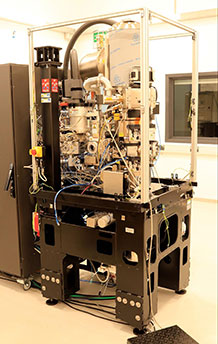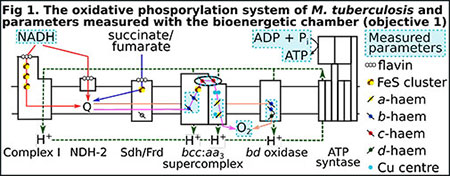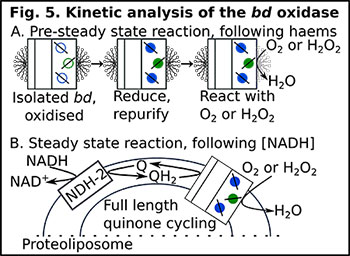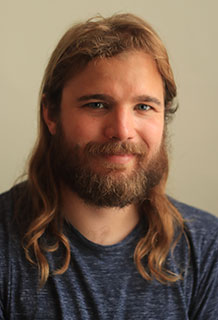Jamie Blaza
UKRI Future Leader Fellow & Honorary Lecturer
Research
Research
Bacterial bioenergetics
Bioenergetic systems provide organisms with the energy they need to live and grow. In aerobic organisms, such as many bacteria and mammals, electrons that have been stripped from nutrients flow down a series of membrane-bound complexes to electron acceptors such as oxygen. The liberated redox energy is used to translocate protons across a membrane, building a proton motive force that is used to drive other reactions away from equilibrium, the most important of which is the phosphorylation of ADP to ATP by ATP synthase. ATP is then used to power the diverse reactions in the cell. The combined activity of the electron transport chain and ATP synthase comprises the oxidative phosphorylation system.
We understand the oxidative phosphorylation systems of a few model bacteria increasingly well, but there is a considerable diversity in both pathogenic and nonpathogenic species that is not captured in these model species. An excellent example of this is the electron transport chain of the mycobacteria group, which includes the causative agents of tuberculosis and leprosy. Many of the complexes of the pathogens are highly divergent from their better characterised relatives, and there remains a huge amount to discover and understand. In addition to being of fundamental interest, these systems are validated drug targets: the approved drug bedaquiline targets ATP synthase and Q203, which has entered phase-2 clinical trials, targets the respiratory supercomplex. Tuberculosis is the deadliest infectious pathogen and causes immense suffering around the globe; drug resistance is growing and threatens current treatment regimens, which are already undermined by drug toxicity and poor patient compliance due to long treatment duration. Therefore, these new drugs are important new additions to our arsenal in the fight against tuberculosis.
Supported by a UKRI Future Leader Fellowship, we hope to understand mycobacterial bioenergetics on three levels:
Structural: What is the arrangement of amino acids and prosthetic groups within these enzymes?
Functional: How does the structure of the enzymes enable catalysis and regulation?
Cellular: How are these enzymes organised and coordinated within the living cell to provide the bacterium with energy to sustain itself and power infection processes?
Methods to enable our research
Our core techniques are largely biophysical, biochemical, and microbiological. While we are not strictly a methods-focused lab, we often work on methods to enable our biological research.
CryoEM
There has been an explosion of high quality cryoEM structures- some at incredible resolutions. However, just as crystallisation is essential for X-ray crystallographic studies, the generation of good cryo-grids underpins every cryoEM project. This is true for all targets, but is particularly critical for some of the targets that are most interesting: delicate membrane proteins and intricate assemblies. Cryo-grids are prepared by plunge freezing very thin water films into a cryogen like liquid ethane, forming thin sheets of vitreous ice that can then be loaded into electron microscopes. Previous experience has shown that in addition to the presence of a large air-water interface, the structure of the substrate of the grid is also critical, for example hydrophilic surfaces are significantly kinder to the protein than carbon. We are hoping to extend these observations with further improved surfaces, using compounds such as sugar dendrimers. These surfaces should be superior for isolated macromolecules but also may allow adherent cells to be grown on the surfaces in a more physiological environment.
York has excellent equipment for cryoEM, with an in-house Glacios mounted with a highly sensitive Falcon-IV direct electron detector. We are keen to use this microscope as a test-bed for new methods, for example the application of materials science techniques to biological problems such as scanning transmission electron microscopy (STEM) imaging methods and electron diffraction.

The York Glacios electron cryo-microscope during installation
Cellular biophysics
Energy transducing enzymes and pathways have unique spectroscopic handles that allow us to quantify them in intact living cells, providing unique insights into metabolism without needing to break the cells and disrupt the system. By bringing together several techniques to work on a single bacterial culture, we will create a ‘bioenergetic chamber’ which will comprehensively measure the bioenergetic status of that culture. The techniques include visible-wavelength spectroscopy, 31P-NMR, and respirometry. Visible-wavelength spectroscopy measures the strong and distinct changes that occur as cytochromes undergo oxidoreduction and provides a read-out of the electron occupancy of the electron transport chain as it passes electrons to O2. Here the naturally abundant 31P isotope of phosphorus in phosphate is used to measure the concentration of phosphorylated metabolites like ATP, ADP, and Pi. The phosphorylation of ADP with Pi to create ATP is the key energy-transducing reaction in the cell, linking the bioenergetic system to all the other processes within the cell. The status of this linkage is a key measure of the energy status of the cell. Respirometry measures the rate of consumption of O2. For aerobic bacteria this measure tells us what the flux through the electron transport chain is, allowing us to calculate the catalytic status of each of the enzymes in the electron transport chain. Bringing all these together provides comprehensive information on the operation of the bioenergetic system in intact living cells without the need for genetic markers or perturbation of the system.

A simplified view of the mycobacterial oxidative phosphorylation system and parameters measured with the bioenergetic chamber
Artificial electron transport chains
Kinetic analysis of enzymes has been a key technique of biochemistry for as long as it has existed. However, respiratory enzymes present a number of difficulties: their quinone substrates are often completely hydrophobic and they generate or are powered by a proton-motive force across a membrane. Historically, workers have either used isolated enzymes or native membrane vesicles. Working with isolated enzymes requires non-physiological short-chain quinones, which can react adventitiously away from the true active sites and the lack of a membrane means a proton-motive force can neither be built or imposed. Native membrane vesicles do not allow control over their inner phase and the large number of enzymes in them often clouds interpretation; the target enzyme concentration is unknown and the other enzymes may catalyse confounding reactions. We are interested in creating artificial electron transport chains comprising the enzyme of interest, a native quinone substrate, and a coupling enzyme to turn-over the quinone, allowing steady-state catalysis. Here, enzyme concentrations are controlled, native substrates are used, the enzyme is in a membrane bilayer, and a proton-motive force can be sustained or depleted using an uncoupler.

A simple artificial electron transport chain, in this case showing how the bd oxidase can be studied using NDH-2 as the regenerating enzyme.
The lab and our ethos
The lab consists of the principal investigator, Jamie Blaza, four PhD students for whom Jamie is the primary supervisor, and a postdoctoral worker (arriving Summer 2021). We also host project students from both the Chemistry and Biochemistry degree programs. We aim to remain a relatively small, focused, and tight-knit team working on the most important questions in microbial bioenergetics.
We have weekly lab meetings on Mondays, which alternate between a detailed presentation given by a lab member, and a roundtable discussion, where we share activities, challenges and progress. There are one-on-one meetings between Jamie and lab members at least once a week.
It’s hoped that some of the alumni from the lab will go on to establish academic careers for themselves when they leave but sadly while setting up your own lab is incredibly rewarding the positions are also highly competitive and often insecure. There are many other equally, or more, rewarding career pathways that academic science prepares people for and during their time in the lab members are encouraged to explore different careers they might be interested in. Short work placements are a mandatory part of some of our PhD programs but may also be arranged (and are encouraged) for everyone.
Equality, diversity, and inclusion are central to the culture of the wider department; the Department of Chemistry was the first department to win a gold award in the Athena SWAN Charter, and is working towards widening access to groups under-represented in science. We are proud to benefit from and contribute to this culture.
Biography
Biography
Jamie studied at the University of Leeds and the National University of Singapore for his undergraduate degree in Microbiology. Working with Mike Webb for two summers, he became interested in the ‘chemical’ side of biochemistry and so pursued a PhD at the MRC Mitochondrial Biology Unit at the University of Cambridge with Judy Hirst, developing biophysical methods to measure proton and electron transfer reactions in mammalian mitochondrial systems.
Following his PhD, he stayed on with Judy as a MRC Career Development Fellow, to learn electron cryo-microscopy (cryoEM) from Vinothkumar Kutti Ragunath (then at the MRC LMB, now NCBS, India), pushing the resolution of the mitochondrial complex I cryoEM maps, allowing the visualisation of key structural features and providing information on the physiological regulation of this crucial complex. After a brief stay in Ben Luisi’s laboratory in the Cambridge Biochemistry Department looking at bacterial antibiotic transporters, he came to the University of York to establish his own group and cryoEM as a technique in YSBL.
At York Jamie is bringing his research interests full-circle, returning to microbiology but using and further developing the biophysical methods he used in his pre-independent journey. In 2021, he won a UKRI Future Leader Fellowship, which supports his group and allows him to dedicate his time fully to the lab.
Projects
Projects
Interested Masters and PhD students are encouraged to contact Jamie for further information about available projects. As our work sits at the interface of biology and chemistry/physics people from either scientific background are encouraged to get in touch.
Publications
Selected Publications
Visit Jamie's Google Scholar page for a full list of publications.
Furlan C*, Chongdar N*, Gupta P, Lubitz W , Ogata H, Blaza JN# , Birrell JA#. Structural insight on the mechanism of an electron-bifurcating [FeFe] hydrogenase. eLife e79361, 2022
Agip AA*, Blaza JN*, Bridges HR, Viscomi C, Rawson S, Muench SP, Hirst J. CryoEM structures of complex I from mouse heart mitochondria in two biochemically-defined states. Nature Structural and Molecular Biology 25, 2018.
Blaza JN, Vinothkumar KR, Hirst J. Structure of mammalian respiratory complex I in the deactive state. Structure 26, 2018.
Milenkovic D*, Blaza JN*, Larrson N-G, Hirst J. The enigma of the respiratory chain supercomplex. Cell Metabolism 25, 2017.
Blaza JN*, Bridges HR*, Aragão D, Dunn EA, Heikal A, Cook GM, Nakatani Y*, Hirst J. The mechanism of catalysis by type-II NADH:quinone oxidoreductases. Scientific Reports 7:40165, 2017.
Blaza JN, Serreli R, Jones AY, Mohammed K, Hirst J. Kinetic evidence against partitioning of the ubiquinone pool and the catalytic relevance of respiratory-chain supercomplexes. PNAS 111, 2014.

